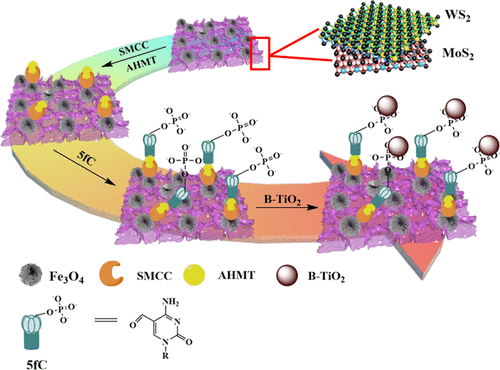Our official English website, www.x-mol.net, welcomes your
feedback! (Note: you will need to create a separate account there.)
Photoelectrochemical Biosensor for DNA Formylation Detection in Genomic DNA of Maize Seedlings Based on Black Tio2-Enhanced Photoactivity of MoS2/WS2 Heterojunction.
ACS Sensors ( IF 8.2 ) Pub Date : 2020-03-11 , DOI: 10.1021/acssensors.0c00036 Fei Li 1 , Siyu Wang 1 , Huanshun Yin 1 , Yan Chen 1 , Yunlei Zhou 1 , Jing Huang 1 , Shiyun Ai 1
ACS Sensors ( IF 8.2 ) Pub Date : 2020-03-11 , DOI: 10.1021/acssensors.0c00036 Fei Li 1 , Siyu Wang 1 , Huanshun Yin 1 , Yan Chen 1 , Yunlei Zhou 1 , Jing Huang 1 , Shiyun Ai 1
Affiliation

|
5-Formylcytosine (5fC) is a rare base found in mammalian DNA, which is thought to be involved in the demethylation of DNA. As a stable epigenetic modification, 5fC participates in gene regulation and cell differentiation, and plays an important role in the growth and development of plants. However, the abundance of 5fC is only as low as 0.002-0.02% of cytosine. Therefore, to further understand the functions of 5fC, a rapid, highly sensitive, and efficient method is needed for detecting 5fC. Herein, a novel photoelectrochemical (PEC) biosensor was constructed for 5fC detection, where a MoS2/WS2 nanosheet heterojunction was employed as a photoactive material, amino-functionalized Fe3O4 and SMCC were used as a linker, 4-amino-3-hydrazino-5-mercapto-1,2,4-triazole was adopted as 5fC recognition reagent, and black TiO2 (B-TiO2) was used as a signal amplification unit. Under the optimal experimental conditions, this PEC biosensor showed a wide linear range of 0.01-200 nM and a low detection limit of 2.7 pM (S/N = 3). Due to the specific covalent reaction between -NH2 and -CHO, the biosensor presented high detection sensitivity, even discriminating 5fC with 5-methylcytosine and 5-hydroxymethylcytosine. The biosensor was then applied to investigate the effect of heavy metal Cd2+ on 5fC content in the root, stem, and leaves of maize seedlings.
中文翻译:

基于MoS2 / WS2异质结的黑色Tio2增强光敏性的玉米幼苗基因组DNA中DNA甲酰化检测的光电化学生物传感器。
5-甲酰基胞嘧啶(5fC)是在哺乳动物DNA中发现的稀有碱基,据认为与DNA的去甲基化有关。5fC作为稳定的表观遗传修饰,参与基因调控和细胞分化,并在植物的生长发育中发挥重要作用。但是,5fC的丰度仅为胞嘧啶的0.002-0.02%。因此,为了进一步理解5fC的功能,需要一种快速,高度灵敏,有效的检测5fC的方法。本文中,构建了用于5fC检测的新型光电化学(PEC)生物传感器,其中MoS2 / WS2纳米片异质结被用作光敏材料,氨基官能化的Fe3O4和SMCC被用作连接基4-amino-3-hydrazino-5 -巯基-1,2,4-三唑被用作5fC识别试剂,黑色TiO2(B-TiO2)被用作信号放大单元。在最佳实验条件下,该PEC生物传感器显示出0.01-200 nM的宽线性范围和2.7 pM的低检测限(S / N = 3)。由于-NH2和-CHO之间发生特定的共价反应,该生物传感器具有很高的检测灵敏度,甚至可以将5fC与5-甲基胞嘧啶和5-羟甲基胞嘧啶区分开。然后将生物传感器应用于研究重金属Cd2 +对玉米幼苗根,茎和叶中5fC含量的影响。甚至将5fC与5-甲基胞嘧啶和5-羟甲基胞嘧啶区分开。然后将生物传感器应用于研究重金属Cd2 +对玉米幼苗根,茎和叶中5fC含量的影响。甚至将5fC与5-甲基胞嘧啶和5-羟甲基胞嘧啶区分开。然后将生物传感器应用于研究重金属Cd2 +对玉米幼苗根,茎和叶中5fC含量的影响。
更新日期:2020-03-11
中文翻译:

基于MoS2 / WS2异质结的黑色Tio2增强光敏性的玉米幼苗基因组DNA中DNA甲酰化检测的光电化学生物传感器。
5-甲酰基胞嘧啶(5fC)是在哺乳动物DNA中发现的稀有碱基,据认为与DNA的去甲基化有关。5fC作为稳定的表观遗传修饰,参与基因调控和细胞分化,并在植物的生长发育中发挥重要作用。但是,5fC的丰度仅为胞嘧啶的0.002-0.02%。因此,为了进一步理解5fC的功能,需要一种快速,高度灵敏,有效的检测5fC的方法。本文中,构建了用于5fC检测的新型光电化学(PEC)生物传感器,其中MoS2 / WS2纳米片异质结被用作光敏材料,氨基官能化的Fe3O4和SMCC被用作连接基4-amino-3-hydrazino-5 -巯基-1,2,4-三唑被用作5fC识别试剂,黑色TiO2(B-TiO2)被用作信号放大单元。在最佳实验条件下,该PEC生物传感器显示出0.01-200 nM的宽线性范围和2.7 pM的低检测限(S / N = 3)。由于-NH2和-CHO之间发生特定的共价反应,该生物传感器具有很高的检测灵敏度,甚至可以将5fC与5-甲基胞嘧啶和5-羟甲基胞嘧啶区分开。然后将生物传感器应用于研究重金属Cd2 +对玉米幼苗根,茎和叶中5fC含量的影响。甚至将5fC与5-甲基胞嘧啶和5-羟甲基胞嘧啶区分开。然后将生物传感器应用于研究重金属Cd2 +对玉米幼苗根,茎和叶中5fC含量的影响。甚至将5fC与5-甲基胞嘧啶和5-羟甲基胞嘧啶区分开。然后将生物传感器应用于研究重金属Cd2 +对玉米幼苗根,茎和叶中5fC含量的影响。











































 京公网安备 11010802027423号
京公网安备 11010802027423号